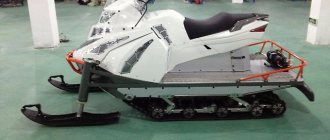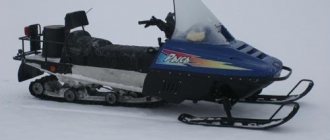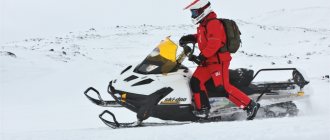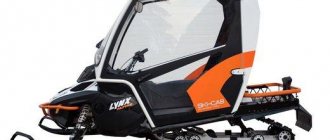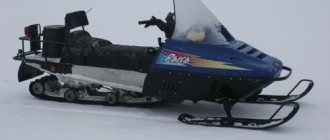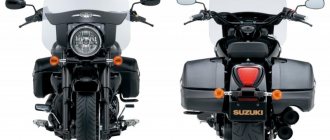Arctic Cat Bearcat 660WT is a multi-purpose American snowmobile that is in demand on the world market. This machine belongs to the class of utilitarian snowmobiles, designed to perform household tasks, as well as suitable for entertainment and travel. This model is in demand in various fields of activity, for example in border areas, and is used as a patrol. The Arctic Cat snowmobile engine is endowed with high traction force, which is necessary to overcome various kinds of obstacles. We also note the strong and reliable frame, optimal chassis settings and high fuel efficiency. All these parameters are, of course, very important for the daily operation of the snowmobile, and its exposure to heavy loads.
The American manufacturer Arctic Cat is one of the most famous developers of specialized equipment. It has a good reputation all over the world, including in Russia - primarily due to the fact that the Americans successfully produce snowmobiles adapted to harsh climatic conditions. One of such models is the Bearcat 660, adapted to the northern regions of Russia. According to domestic consumers, we have one of the best snowmobiles in terms of quality, reliability and performance. The device in question really has impressive performance parameters, which, however, has been confirmed by factory tests and many years of practice. The vehicle of the same name combines off-road capabilities, maneuverability, reliable components and assemblies, as well as high technology.
Of the main advantages of this model, we note the following aspects:
- Sharp handling and quick ski response when turning the steering wheel, regardless of the road surface
- Fuel economy and good environmental performance, despite the high power of the internal combustion engine
- Modern AWS VII suspension of our own production
- Using durable components and assemblies tested under harsh conditions.
Video
The suspension of the Arctic Cat Bearcat 660 snowmobile deserves special attention. Thus, AWS VII acts as the front chassis. This is the name of the suspension, reinforced with double hydraulic shock absorbers. This design solution allows you to reduce vibrations and noise when driving on relief roads and difficult obstacles. The rear also uses a proprietary suspension created using Articulating technology. Its special feature is the rear Torque Sensing Link, which controls engine torque, which is especially important when transporting heavy cargo trailers. In addition, the rear suspension is also supplemented with torsion springs, which can be adapted to certain operating conditions (by changing operating modes). The result is a rear suspension that is durable and functional, creating comfortable conditions for smooth operation and excellent handling.
In addition to the above, the Arctic Cat 660 snowmobile received a proprietary ACT DiamondDirectDrive drive, which prevents large waste of energy transmitted from the engine. This thus ensures good energy reserves and has a positive effect on efficiency. In addition, the basic package includes a massive roller pulley, which is characterized by high strength and long service life.
The brake part of the snowmobile of the same name is made in compliance with all safety standards. The brakes are configured in such a way that the snowmobile is able to stop almost instantly on an inclined surface, as well as at high speeds. The fact is that the main element of the braking part is disc brakes, which are practically resistant to overheating.
The engine must be started using an electric starter, but if necessary, an emergency start can be used - for example, if the temperature is too low. In fact, emergency starting is one of the elements of adaptation to harsh operating conditions - for example, at temperatures of minus 50 degrees. In addition, the power plant has its own heating.
In the basic version, the car is a two-seater, but in extreme cases it is possible to remove the passenger seat. In this case, the car will become a single-seater, but there will be additional space for placing cargo. In addition, the removed seat can be used as a chair, very popular among anglers.
The snowmobile comes standard with a variety of options, including fuel and speed gauges, trip meter, odometer, electric start, 2 rear view mirrors, 2-person seat, tow bar, oil level and oil pressure, and engine temperature. . All these options allow you to monitor the condition of the snowmobile in real time. In addition, some of the elements are aimed at increasing comfort and coziness during long hours of driving.
Price
You can currently purchase a completely new snowmobile at a cost from 350 thousand rubles to 600 thousand Russian rubles. The final cost of the machine may vary depending on the year of production and model configuration.
A used snowmobile can be purchased at a cost ranging from 280 thousand rubles to 435 thousand Russian rubles. The cost of this option directly depends on the year of production, general technical condition, number of engine hours worked and kilometers traveled.
Specifications
- Length – 3380
- Width – 1180 mm
- Minimum/maximum ski track width – 960/1010 mm
- Front suspension – AWS VII with two hydraulic shock absorbers
- Rear suspension – Articulating Rear Suspension, with adjustable torsion springs
- Rear shock absorber parameters – 50 mm (diameter)
- Rear Link – Torque Sensing Link
- Front/rear suspension travel – 200/340 mm
- Propulsion - caterpillar type, with front drive sprockets
- Caterpillars, pcs. - 1
- Tension mechanism – screw
- Caterpillar belt – reinforced, rubber-fabric
- Track length/width – 3960/510 mm
- Grouser height – 25 mm
- Gearbox – variator, with positions “front”, “down”, “back” and “neutral”
- Brakes – hydraulic disc
- Electric start - yes
- Manual start - yes
- Ignition – capacitor CDI
- Lubrication system - with electronic injection
- Weight – 325 kg
- Towing weight (carrying capacity) – 500 kg
- Fuel tank volume – 56 liters
- Layout – double
- Exhaust system – with muffler and exhaust pipe
Basic elements:
Electric starter, reverse gear, heated steering wheel grips and throttle trigger, windshield, passenger backrest, speedometer, odometer, rear towbar, 55/60 halogen front headlight, LED tail light.
Model features
- Excellent stability. Due to the wide arrangement of skis between each other, the snowmobile rests confidently on the snow surface. The developers have minimized rollovers.
- Dynamic, traction engine with a power of 80 units.
- Modern shock-absorbing suspension consisting of front "AWS VII" and rear "Articulating" suspension.
- Durable steel frame.
- High quality of execution of all components and parts in general.
As you have already seen, the model is really worth buying. For those who are looking for something more powerful, designed specifically for harsh domestic conditions, we offer a review of the giant Arctic 1500 snowmobile.
Engine
For performance in the Arctic Cat 660 snowmobile, a three-cylinder gasoline unit with an electronic fuel injection system is responsible, which efficiently enters the combustion chamber. Three cylinders have a total displacement of 0.6 liters, which is enough for the high traction capabilities of the internal combustion engine. At the same time, the engine power is just over 50 horsepower, and the role of ventilation of the engine components is performed by a liquid cooling system, which allows the machine to be operated at sub-zero temperatures. The powerful four-stroke engine consumes 15 liters per 100 km, which is an economical result.
Snowmobile "Arctic 1500"
What is the Arctic 1500 snowmobile? - This is a unique snow transport, which is difficult to find areas where it does not pass. The equipment is quite multifunctional and can be used by fishermen, hunters, and outdoor enthusiasts. There is also an opinion that the unit will enter the service of border guards to patrol the border.
The snowmobile was created taking into account the climatic conditions of Russia. The main advantage of this snowmobile is the use of a VAZ 2108 automobile engine. It provides good traction, which is sometimes so lacking in harsh winter conditions. In the event of a breakdown, it will not be difficult to find the necessary part, since they are sold in any car store. It is worth noting the high efficiency of the model; the snowmobile consumes about 18-20 l/100 km. Due to the low specific pressure on the snow cover, the snowmobile has the ability to move through snow about 1 meter deep. This is quite difficult to imagine on other snowmobile models. Good traction allows for towing with a trailer.
The manufacturer develops special passenger and cargo trailers. The first option is designed for 9 people, the second can accommodate cargo with a total weight of up to 1.5 tons. An important factor is the presence of electric power steering, which greatly simplifies the process of operating the equipment. For comfortable use of the equipment, the gas handles are heated. The roller-type rear suspension works best on uneven surfaces. The resulting snow in the tracks is freely released from under the snowmobile. There is a telescopic suspension installed at the front. In practical tests, several tests were carried out with overcoming stumps and stones. It has been proven that a snowmobile literally “flies” over obstacles without causing damage to itself. Let us emphasize once again that the power unit primarily provides excellent traction characteristics, but not speed characteristics. This is an excellent “helper” for rural residents, one might say an avid “worker”. The productive element has a long service life. The manufacturer claims that the engine will operate for 10-15 years, without any major repairs. You just need to change the engine oil in a timely manner.
Reviews
- Alexander, Novosibirsk. I have been using the car for two years. Overall I am pleased with the technology; no particular problems arise. It’s good that the engine is not equipped with turbocharging, which would certainly cause problems, since boosting has a negative impact on the life of the internal combustion engine. Six months ago I discovered oil leaking from the gearbox. I did not find the cause of the leak - I removed the lid and sealed everything thoroughly, and no more leaks occurred in this place. I can assume that snow gets through the mesh on the hood, then it melts and flows out under the transmission, after which it freezes and ice forms, which lifts the cover, causing oil to leak out. Unfortunately, this is not a warranty case, so you have to figure it out yourself. Well, let's see what happens next. So far, this is the only most mysterious problem that has occurred with the Arctic Cat 660 snowmobile. The machine travels about 350 kilometers on one tank, which is an excellent indicator.
- Sergey, Krasnoyarsk. A decent device for its age. It is already more than 8 years old - I bought it in 2005. The snowmobile has already had two owners, I am the third. I can definitely say with confidence that Arctic Cat has one of the lowest fuel consumption results. At least among four-stroke engines. I will note the spacious trunk, which becomes even larger if you remove the passenger seat. But if necessary, three people can ride together, and the engine thrust will be enough to accelerate to 40-50 km/h. The windshield is a little low, because of this the cold wind blows strongly, straight into the face. So you can’t do without a helmet to avoid bending. Maybe my height is also to blame - I’m 185 cm. I was upset by the fragile plastic bumper, which not only cracks in the cold, but can also become deformed when hitting a solid obstacle. But I was pleased with the performance of the engine - it is lively and groovy, but a little noisy and emits vibrations. The car does not suffer from breakdowns.
Snowmobile "Arctic 1500" - technical part
A car four-stroke engine with 4 cylinders is installed. The working volume is 1490 cc. The performance element produces 79 hp. The supplier recommends refueling equipment with AI-93 fuel. The power unit is cooled by a liquid system. The fuel supply system is carburetor.
Main parameters of the snowmobile: length - 3260 mm; height - 1400 mm; width - 1150 mm. The model is two-seater, the weight of the model is 480 kg. The maximum speed is 75 km/h. There are skis of the support-turn type installed at the front. The gearbox consists of two stages and a reverse function. The engine is started by an electric starter.
Arctic Cat T660 Turbo Touring Logbook (2007)
Greetings to all readers!
As was said in the review about Dzhiman, the long weekend was not in vain! A trip to Usinsk raised the level of adrenaline in the blood and inspired me to take another trip, but this time on a snowmobile.
There are interesting places near Naryan-Mar, the capital of the Nenets Autonomous Okrug. After asking my comrades about the route, the first attempt was made on February 25, but either I didn’t understand well, or they explained it poorly, but I didn’t get there the first time. On Sunday, in sunny weather, i.e. On the 26th, my wife and I hit the road!
Help from Wikipedia:
Pustozersk , (in some sources Pustozersk ) is a disappeared city in the lower reaches of the Pechora, in the Polar region of the Nenets Autonomous Okrug (the author’s opinion does not always coincide with this folk resource!).
For general development, I’ll make another larger reference - if someone is not interested in the story, then read 3 paragraphs below, and then there will be impressions and photos.
Help from there:
Pustozersk was founded in the fall of 1499 by decree of Prince Ivan III by a military expedition. In 1502, Pustozerskaya volost was established. In 1586, the Pustozerskaya volost was expanded by annexing the Ust-Tsilemskaya and Izhemskaya settlements, which were separated from the Vymskaya volost. At the beginning of the 17th century. Pustozersky district was formed. It included Pustozerskaya volost, as well as Izhemskaya and Ust-Tsilemskaya volosts. Pustozersky district extended from the Mezen River to the Urals and from the Barents Sea to the Vychegda River. By that time, Pustozersk had about 2 thousand inhabitants.
For almost three centuries (until 1780), Pustozersk was the administrative, commercial, cultural and religious center of the Pechora region. In Pustozersk there was a voivodeship, there was an official hut, a customs house, a prison, trading shops, a house for “miners” and a tavern. In 1681, a cathedral church was erected in the name of the Transfiguration of the Lord, and two parish churches were built at the temple - the Presentation of the Most Pure and St. Nicholas. Officials and military men who performed sovereign service lived in the city. Since there is no arable land here, the population was engaged in fishing, hunting, animal husbandry, sea animal hunting and trade. According to the payment book “Pomeranian Pustozersky volosts”, dated 1574-1575, in Pustozersk there were “92 Russians, 52 Permyaks, and a total of 144 households, and the people in them were Russians and Permyaks - 282 people,” that is, taking into account women and children, the city's population was up to 500 people.
There is also a lot of information for those who are interested in search engines to help.
The snowmobile was brought from the “land” last summer. The trip is covered in a review of the Suzuki-Jimny, where the trailer turned out to be larger than the car. Filya the cat is still wanted, no other game has been acquired((
Snezhik is worthy in terms of characteristics - Artik Ket T660 Tourist - power 110 l / s, Suzuki 4-stroke turbocharged engine - travels along the roads very quickly and comfortably. But there are a couple of drawbacks - the goose is 38 cm (a bit narrow) and weighs more than 300 kg! You can’t just pull one out of the snow like that((As the saying goes: “To dig is not to dig!” This is a limousine on a snow grader.
And now to the beginning! On the 26th they rushed! Average speed is about 60 km/h. We reached the village of Ustye, talked with a local resident - a kind guy was chopping wood, congratulated him on Maslenitsa, wished God for help and asked about the way (I doubted it a little, but they don’t take money for asking). from Ustya to Pustozersk it is just over 3 km. At first they flew by, but they realized it, and the mystery of history began...
White column - The Pustozersk monument was erected in 1964. Apparently this is the custom among people - first to lose, and then to try to perpetuate.
Here, together with three other leaders of the Old Believers - priest Lazar, deacon Fyodor and monk Epiphanius, is the place of execution (burning in a log house) of Archpriest Avvakum (the leader of the church schismatics of the church) in April 1681.
Avvakum wrote “The Life of Archpriest Avvakum, written by himself” - in principle, this is the first Russian novel in the language of the 17th century. A modern language version is already available on the Internet.
An almost empty snowy field - the past cannot be returned... Sadness, melancholy, loneliness, emptiness, the loud piercing cry of a raven... and this is on a sunny day, but this is our story.
The Old Believer Chapel of Avvakum, which is periodically visited by pilgrims and tourists.
The refectory of St. Anastasia, which is named in memory of the wife of Archpriest Avvakum, who died of hunger.
It is not right to make a story without demonstrating the main character - the vehicle! Artik Ket T660 Touring in person in the rays of the polar sun.
We leave the historical place with the words of the classic: “Russia cannot be understood with the mind, Russia cannot be measured with a common yardstick.” As one traveler wrote in livejournal: “Abandoned in the mid-twentieth century, Pustozersk is rather the disembodied spirit of a decayed city.”……………………………………………………………(((
My life partner, navigator, co-driver and of course my wife!
Due to the remoteness (I apologize for the strange word) of the “land”, which can only be reached by road in winter, and in summer also by barge (400 km along Pechora), but the main transport is by plane! Such signs with directions from local villages, Moscow and all the way to London and Disneyland make it possible to understand that somewhere there is a “land” with its vanity, crowds and the order of life.
Today (03/05/2017) we visited Pustozersk with our son. The weather was completely different from the photo((Cloudy, gloomy and heavy snow! We had to dig out the snowmobile 4 times, but Kotyara behaved with dignity and power! We arrived home 5 hours later instead of the planned 2-3, soaking wet, partially exhausted, but happy from the sensations received and the professional photos taken, it is possible for the competition! Snezhik reaches 100 km/h on the road without effort - there is still a lot of reserve, it sniffs gasoline, and continues to bring emotions from trips.
